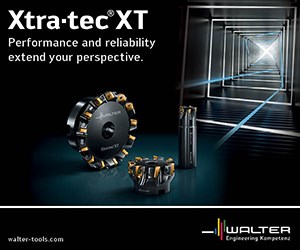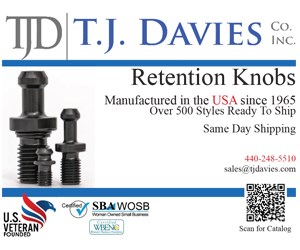Stepping Up To Hole-Making Challenges
Lately, several cutting tool manufacturers have re-examined indexable insert drills, seeking to overcome the disadvantages of unbalanced cutting forces inherent in their design. One of the most recent developments along these lines is the CoroDrill 880 introduced by Sandvik Coromant.
This video demonstrates the use of stepped insert designs in hold making operations
The problem with many indexable insert drills is that they have two inserts whose cutting edges overlap to produce the correct cutting diameter. So even though the drill has two flutes, the inserts function as a single but asymmetrical cutting edge. Such designs are inherently unbalanced. As a result, indexable drills have had to compromise feed and speed when entering a cut, forcing the user to make a trade-off between economy and productivity.
Another problem with the unbalanced entry is hole tolerance. Typically, the center insert of an indexable drill enters first. This creates a large radial cutting force, which tends to cause deflection in the drill body. Once the drill is pushed off-center, it cannot produce a close-tolerance hole.
For these reasons, indexable drills have generally been limited to rough drilling of holes. Where tolerances closer than 0.012 to 0.016 inch total are required, it has been necessary to follow the indexable drill with a secondary operation.
Lately, several cutting tool manufacturers have re-examined indexable insert drills, seeking to overcome the disadvantages of unbalanced cutting forces inherent in their design. One of the most recent developments along these lines is the CoroDrill 880 introduced by Sandvik Coromant (Fair Lawn, New Jersey). According to Bruce Carter, a Sandvik product specialist, the design of this indexable drill sidesteps the problems created by unbalanced cutting forces, thus improving productivity and hole quality while retaining the economy of having inserts with four usable edges.
The key is a concept that the company calls "Step Technology." This phrase describes the "step-by-step" entrance of the insert cutting edges into the workpiece, which is said to greatly reduce the radial cutting forces associated with indexable drills in the past. The concept involves two inserts with different geometry and different cutting characteristics. The center insert has a noticeably irregular edge geometry, while the peripheral insert incorporates a wiper geometry.
In the first step of entering the workpiece, the outside corner of the center insert contacts the workpiece. This allows the drill to begin cutting with relatively low radial forces, minimizing deflection. In the second step, the outer corner of the peripheral insert contacts the workpiece. This balances the force generated by the center insert. In the third and last step, the remaining part of the central insert begins to cut. All three steps are indicated in the illustration (above).
Mr. Carter says that by entering the cut in three relatively small steps, the cutting forces are reduced to less than half those produced by typical insert drills, balancing each other so that deflection on entry is virtually eliminated. The combination of balanced entry, low radial cutting forces, and minimal deflection produces several benefits:
- More accurate hole tolerances.
- The possibility to increase feed rates as much as 100 percent, depending on material.
- The possibility to run drills as long as four or more times the diameter with more confidence.
- The possibility to eliminate secondary hole-sizing operations, depending on the tolerance demands.
Another benefit cited is that the design allows the peripheral insert to have four fully usable cutting edges. Some indexable drills with square inserts sacrifice the fourth cutting edge if feeds are above 0.005 ipr. However, with the Step Technology, the unusual shape of the central insert protects the fourth cutting edge at feeds as high as 0.013 ipr.
Finally, Mr. Carter points out that the wiper technology of the peripheral insert produces an excellent surface finish even at the higher feeds possible with the new design. In tests, surface finishes of 20 microinches were attained at feed rates of 0.004 ipr, and 80 to 120 microinches at feed rates as high as 0.013 ipr.
Related Content
Selecting a Thread Mill That Matches Your Needs
Threading tools with the flexibility to thread a broad variety of holes provide the agility many shops need to stay competitive. They may be the only solution for many difficult materials.
Read MoreToolpath Improves Chip Management for Swiss-Type Lathes
This simple change to a Swiss-type turning machine’s toolpath can dramatically improve its ability to manage chips.
Read MoreHow to Turn Machine Shop Downtime Into Process Expertise
To take advantage of a lull in business, JR Machine devised a week-long cutting tool event that elevated the shop’s capabilities with aerospace alloys.
Read MoreTwin Spindle Design Doubles Production of Small Parts
After experiencing process stalls in the finishing stage of production, Bryan Machine Service designed an air-powered twin spindle and indexable rotating base to effectively double its production of small parts.
Read MoreRead Next
The Cut Scene: The Finer Details of Large-Format Machining
Small details and features can have an outsized impact on large parts, such as Barbco’s collapsible utility drill head.
Read More3 Mistakes That Cause CNC Programs to Fail
Despite enhancements to manufacturing technology, there are still issues today that can cause programs to fail. These failures can cause lost time, scrapped parts, damaged machines and even injured operators.
Read MoreObscure CNC Features That Can Help (or Hurt) You
You cannot begin to take advantage of an available feature if you do not know it exists. Conversely, you will not know how to avoid CNC features that may be detrimental to your process.
Read More















.png;maxWidth=300;quality=90)










